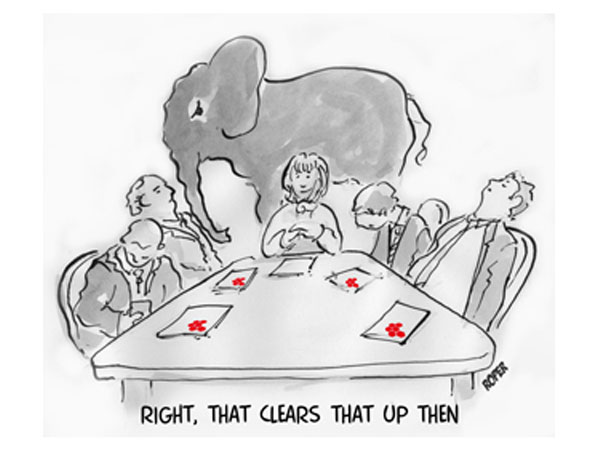Many of our clients have concerns about tensions in their team. Sometimes there is open conflict for all to see – there are raised voices, nasty gossip and obvious finger-pointing. But more often, the bad feelings are below the surface, and those unspoken tensions are equally damaging for the team and for business.
Everyone knows they’re there, everyone knows they’re getting in the way of performance – but nobody knows how to resolve them.
Working with clients over many years we’ve seen how this situation evolves. It often starts with a harmless incident such as someone getting the wrong end of the stick, someone feeling let down or misreading a situation. The problem then lies with never surfacing and resolving what are probably, at this stage, just hurt feelings, others’ misperceptions, and minor tensions.
We often say this is like never sweeping under a rug. The bumps accumulate and get bigger until eventually you can’t even walk on the rug.
What can you do?
A recent piece in the Harvard Business Review (HBR) by an expert in mediation and conflict resolution highlighted four reasons that mediation can fail, and the different type of approach you need to adopt in any given situation of conflict in your team.
Four reasons mediation fails
High intensity
You need to be realistic. However good your intentions are as their manager, the higher the intensity of a conflict between people, the more likely it is for mediation to collapse.
When people are in ‘fight or flight’ mode it’s quite possible that someone will storm out or lose the plot, and the relationship will be more damaged.
Competitive relationships
In situations where individuals or groups are directly competing against one another (especially over limited resources or funding) mediation can be difficult. In such cases there is a tangible reason for them being at odds with each other, as opposed to more intangible feelings and personal history. We see this in businesses that are heavily geared towards a bonus culture. Often the conflict arises simply because of the remuneration structure and a reluctance to share fees.
Limiting conditions
Sometimes conflict can be resolved quite quickly if there is an obvious shift in mindset.
But to suggest that two people can work out their issues in a single meeting might be ambitious. Working things out takes as long as it takes and a lack of time, or other business constraints can be problematic.
Unspoken issues and hidden agendas
There is little point in mediating if there are significant unspoken issues, tensions and agendas. In such cases it’s important that before the group meet, the individuals have had the opportunity to speak frankly and freely to the facilitator, who (ideally) should not be part of their organisation.
Once these one to one meetings have happened, the individuals need to be confident that there is a structure in place to ensure that the group meeting doesn’t break down.
Four different approaches
For each of these four conflict scenarios, you need to adopt a different approach. The HBR suggests the following:
The medic (high intensity)
You need to gauge and control the intensity of a conflict. We recommend defusing a session through having a confidential one to one meeting with each participant beforehand. Allowing them to let off steam and feel heard is the best starting point.
Before we work in any of these situations with our clients we always set out (and get participant agreement on) a set of Leaders Lab meeting groundrules. These give a structure to the meeting and are great as rules of engagement.
The referee (competitive relationships)
This is more of a negotiator role. It’s important to be fully aware of, and acknowledge, the tangible parameters of the conflict situation. If this is more about facts than feelings, then it may be possible to help the parties negotiate trade- offs and compromises so that the resolution is a win/win for those who were at odds.
The fixer (limiting conditions)
When the conflict is due to constraints on the situation (such as a tight deadline) you can help by identifying the difficulties for the team and perhaps use your leverage and influence as a manager to help them get past these constraints and create a more co-operative dynamic.
The counsellor (unspoken agendas and issues)
In order to uncover the issues that underlie the conflict you need to actively listen and ask open questions without judging. People may need space to air their grievances and you will also have more of an insight into some of the deeper challenges they may be facing.
Unless you’re trained as a mediator or facilitator, confidently dealing with conflict in your team is a challenge. But avoiding conflict and letting tensions simmer is a risk and will damage the team culture and performance.
If you’d like to chat through any of these issues about resolving conflict, call us on 07770 221166 or email ab@leaderslab.co.uk
